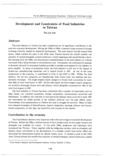Development and Constraints of Food Industries in Taiwan
JIRCAS international symposium series
| ISSN | 13406108 |
|---|---|
| 書誌レコードID(総合目録DB) | AA1100908X |

本文フルテキスト
intlsymp-7_179-190.pdf338.05 KB
The food industry in Taiwan has been conspicuous for its significant contribution to the post-war economic development. During the 1950s to 1980s, it earned a large amount of foreign exchange critically needed for industrial development. The most typical was the canned food sector, which reached the apex in the 1970s when Taiwan became the world's number one exporter of canned pineapple, canned mushroom, canned asparagus and canned bamboo shoot. But starting from the 1980s, the international competitiveness of the food industry in Taiwan was faced with a sharp increase in the production cost. Fortunately, the contemporary upsurge in domestic demand for processed food has provided a suitable environment for the industry to grow steadily. In terms of production value, the food industry is still one of the largest in twenty-two manufacturing industries, and it ranked fourth in 1997. As one of the main components of the economy, it contributed to 6.1% of the GNP in 1997. Within the food industry, the top five categories are slaughtering, feed, frozen food, rice husking and nonalcoholic beverages. The single largest export category is frozen food, accounting for more than 60% of total food export in 1997. On the other hand, the three largest import categories are alcoholic beverages, frozen food and tobacco, which altogether accounted for 44% of the total food import in 1997.
The food industry in Taiwan has been confronted with a number of constraints, such as labor issues, raw material acquisition, foreign competition, environmental protection and distribution. In addition, the outbreak of foot-and-mouth disease which occurred in early 1997 has interrupted the stable growth of the industry achieved over the past fifteen years. Nevertheless, food manufacturers in Taiwan are used to struggle for survival. Many of them have adopted strategies of diversification, channel integration, strategic alliance and international cooperation, so that they can stand firm and compete in the market.
The food industry in Taiwan has been confronted with a number of constraints, such as labor issues, raw material acquisition, foreign competition, environmental protection and distribution. In addition, the outbreak of foot-and-mouth disease which occurred in early 1997 has interrupted the stable growth of the industry achieved over the past fifteen years. Nevertheless, food manufacturers in Taiwan are used to struggle for survival. Many of them have adopted strategies of diversification, channel integration, strategic alliance and international cooperation, so that they can stand firm and compete in the market.
| 作成者 | Tin-yin Liu |
|---|---|
| 公開者 | Japan International Research Center for Agricultural Sciences |
| オンライン掲載日 | |
| 号 | 7 |
| 開始ページ | 179 |
| 終了ページ | 190 |
| 言語 | eng |
